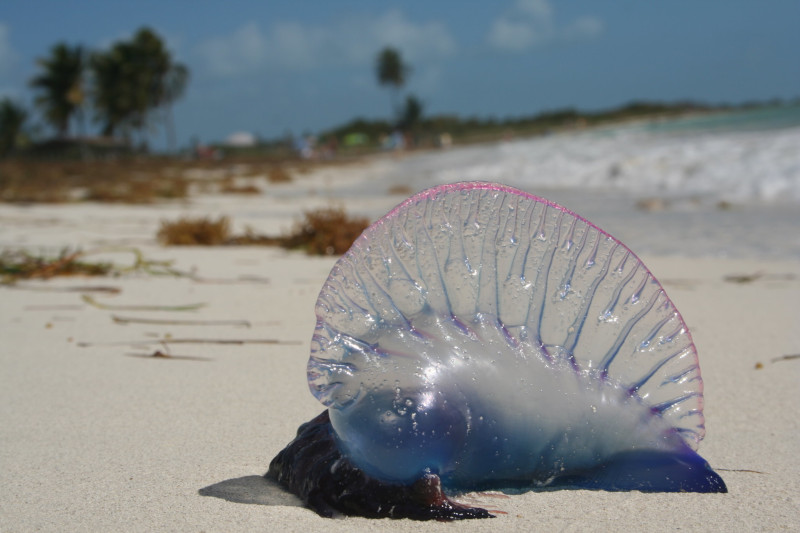Portuguese Man O’ War Facts
- Firstly, the sincerely amazing species known as the Portuguese Man O’ War remains a particularly dangerous variety of marine hydrozoan. This holds true due to a particularly remarkable physical capacity. That’s the fact that its numerous tentacles have the capacity to deliver multiple highly toxic stings to its prey. These stings also rank as extremely painful.
- Secondly, despite its jellyfish-like physical appearance, this fascinating creature does not, in fact, represent a species of true jellyfish. In fact, this rather intriguing species actually constitutes a type of life form known as a siphonophore. This makes the animal a colonial being, whereas a true jellyfish actually represents an individual multicellular creature.
- Furthermore, the impressive species bears the somewhat unimpressive scientific name of Physalia physalis. However, it remains much more widely known by its attention-grabbing common name, the Portuguese Man O’ War. Quite understandably, it earned this name due to its supposed resemblance to an 18th-century sailing ship.
Related Articles
Portuguese Man O War Physical Description
It must be pointed out that individuals of the Portuguese Man O’ War most commonly vary quite significantly in terms of overall physical size. Furthermore, this frequent variation in mature size is one that it shares with many related species. Nevertheless, certain physical dimensions remain reasonably consistent among most of the specimens observed.
First of all, its inflatable sack typically measures about 12 in (30.5 cm) in length. This feature further measures an average of 5 in (12.7 cm) in overall width. The remarkable hydrozoan also displays a prominent sail on its upperside. This growth can be as long as 11.8 in (30 cm) long and stand up to 6 in (5 cm) tall. It also displays color patterns of purple, pink, blue, and mauve.
However, the astonishing tentacles of the gorgeous and impressive Portuguese Man O’ War represent the feature for which it remains best known That holds true mainly due to their sheer length. This occurs because these tentacles attain an average length measuring roughly 165 ft (50.3 m). These extensive appendages contain the animals’ powerful venom.
- Kingdom: Animalia
- Phylum: Cnidaria
- Class: Hydrozoa
- Order: Siphonophorae
- Family: Physaliidae
- Genus: Physalia
- Species: P. physalis
Portuguese Man O War Distribution, Habitat, and Ecology
The sincerely magnificent animal known commonly as the Portuguese Man O’ War also stands out due to its habitat range, as well as for other reasons. That’s because it inhabits a very broad range of the world. More specifically, it appears in the Pacific Ocean, Indian Ocean, and Atlantic Ocean. This makes it among the most widely distributed of all known cnidarians.
Regardless of where it appears, however, it has quite simple but specific habitat preferences. This holds true due to the fact that it lives its life entirely on the surface of the ocean. Furthermore, its gas-filled bladder, known to science as the pneumatophore, stays on the surface. That’s because this part keeps the creature afloat. The rest of its body remains submerged.
The numerous tentacles drag along beneath and behind the Portuguese Man O’ War, floating freely. This occurs because of the nature of the creature. That’s because this fascinating species possesses no means of independent motion. It remains entirely at the mercy of he wind, waves, and ocean currents for its movement. As a result, its movements remain completely random.
This surprising invertebrate evolved solely as a carnivorous species. The dangerous tentacles it develops serve as its means of acquiring food. The toxins these secrete paralyzes and often kills the numerous small fish that it preys upon. Although not typically fatal to humans directly, multiple stings can cause paralysis. This can prove fatal if the human victim is in deep water.
Species Sharing Its Range
Check out our other articles on 7 Wondrous Wasps Worldwide, Crowned Eagle, Havasu Falls, Nevin’s Barberry, Bald Uakari, Tiger Shark, Lange’s Metalmark Butterfly, Mary River Turtle

